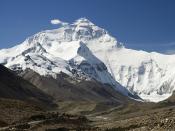There is a best-known legend handed down among the Tibetans in China. It goes like that: five beautiful goddesses killed the five-headed dragon that tried to destroy the serenity of the sea about which the Himalayan mountains exist now. The goddesses turned the sea into fertile land at the plea of the people and became the five main peaks forming the Himalayas in order to bless and protect the people forever. Thought this is not the true formation of the mountain chain, the attraction of the Himalayas is no less than that of the legend. In all kinds of landforms China boasts, no other landmarks has the equal importance to that of the Himalayas which is the highest point on the earth, the considered backbone of Chinese people and the sources of the two main rivers from which the Chinese civilization derived from.
Since the real formation dated from 4 million years ago, the Himalayas has been being the highest mountain system on the earth, which makes it the most distinguishing landscape feature.
During the tectonic plates' movement, the Indian plate crashed under into the Eurasian plate and the two edges squeezed upwards. The Himalayas rose from the ocean, which is coincident with the legend, becoming the highest, longest and youngest mountain Chain. The average altitude of the Himalayan region is 6000m and its highest peak-- the Mount Everest has an altitude of 8848.13m. This great Titan is so easily noticed that it not only serves as a natural guide for the spacecrafts, but also has a prominent meaning for Chinese people.
In the ancient time, the Tibetans revere the Himalayas as their almighty God while now it is considered the invincible backbone of all the Chinese people. The pyramid shaped Mount Everest represents unity and ambition. Above the altitude...


